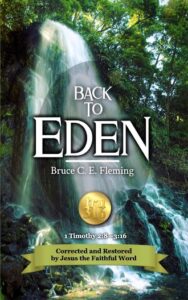
Go deeper? Get the full book!
WHAT DISTINCTION is Being Made in 1 Timothy 2?
A Tru316.com blogpost by Bruce C. E. Fleming
In 1 Timothy 2:13 there is NO distinction being made based on any “creation order.” That idea is being pasted over the meaning of Paul’s point in bringing up Adam and Eve.
In 1 Timothy 2:13-15a Paul DOES make a distinction between first and second degree offenders. Paul had been a second degree offender as had Eve in the Garden of Eden. First degree offenders who sinned on purpose received severe punishment. Those who offended, but not on purpose, could receive mercy and even appointment in God’s service going forward! This had been the case for Paul and for Eve. It was also the case, he told Timothy, for the wayward women overseers he was retraining to minister once more in the church.
Let’s think clearly about the ideas that form Paul’s passage in 1 Timothy 2.
First, a bit of BACKGROUND
- Paul is giving Timothy instructions on how to deal with the overseers who had gone astray. In 1 Timothy 1:3 he wrote:“Just as I urged you upon my departure for Macedonia, to remain on at Ephesus so that you would instruct certain people not to teach strange doctrines,” (NASB)
- Who are those “certain people”? They are former overseers in the churches at Ephesus who had gone astray into false teaching and bad practice. And it looks like both men and women were involved. The Greek word for “certain people” is tisin and it is inclusive of both men and women in that verse.
- Where does Paul give Timothy details on how to instruct those people? Note that the Greek word for “certain people” is tisin and it is inclusive of both men and women in that verse.
Second, a bit of PRECISION
- What were these overseers doing wrong? They were disrupting the church. Paul listed three sins of his in 1 Timothy 1:13. These three sins he then uses as an outline of major points as he writes the next major section of his letter to Timothy. When he gets to the third sin he has arrived at the sin of the wayward overseers. They had been injurious and were disrupting the church.
- Who were they? Paul breaks them into two groups and he gives Timothy instructions about each group in turn. First, there were the men overseers who had gone astray (1 Timothy 2:8). Second, there were the women overseers who had gone astray (1 Timothy 2:9-15). He keeps both groups in mind because there is NO VERB in the first sentence about the women at the start of verse 9. His command from the start of verse 8 that applied to that group of men who Timothy was correcting also applied to that group of women that Timothy was correcting.
- What could they hope for? Both the group of men and the group of women being corrected by Timothy could aspire to serve again. This is what he writes about in 1 Timothy 3:1! “If anyone (tis) aspires to oversight that one desires a good work.”
Third, WHAT Paul was saying
- In verse 8 Paul told Timothy how to correct the group of wayward men In verses 9-15 Paul told Timothy how to correct the group of wayward women overseers. Each group was to cease their false teaching and bad practice.
- In verses 9-10 Paul talks about how to act as a proper woman overseer (verses 9a and 10) and how not to act (verse 9b).
- “LET LEARN!” In verses 11-12 he writes one long sentence that has as its main idea the imperative verb which is “Let learn!” Many people skip over this important imperative. It is the main idea in verses 11 and 12. There is a repetition (en hesukia) located at the start and at the end of this long sentence. This is the literary device of inclusio. Having “in quietness” on either end indicates this is one long sentence.
- Let WHO learn? In the Greek text the word used is “woman.” To answer just who this is many people move outside the literary and historical context of the passage at this point. They speculate on all kinds of people or individuals who they suggest Timothy was to let learn. Some say “all women,” some say “all wives,” some say only “one woman.” Some suggest this imperative only applied in Paul and Timothy’s day and only in Ephesus. Yet the applicability for all time and all places for the following verses such as 1 Timothy 3:1 is not challenged and should not be here.
- Let THEM learn? What about the subgroup of women overseers who had gone astray? They were described immediately preceding in verse 9b. Some more details were given about them in verse 12. Grammarians tell us that a singular noun that has no article as in the case of “woman” (guné) in 1 Timothy 2:11 can stand for a subgroup of women. In this case the subgroup refers to women overseers who had gone astray and were to be retrained. These women apparently wanted to learn and Timothy was to let them learn.
- Let them learn WHAT? We can learn ourselves what they were to learn by how they were to learn. They were to learn “in quietness” and “in submission.” This is how rabbinical students learned in Paul’s day. When they learned in this way it was expected that they themselves would one day teach others like they had been taught. These women were to learn what a good overseer would be teaching others in church. An early example of this happened when there were some people set aside to serve as deacons so that the others could give their attention “to prayer and the ministry of the word” Acts 6:4 (NIV).
- Why bring up the Garden of Eden? Perhaps there were some in Ephesus who were not willing to let these women learn so they could in turn serve once again. Were there some who wanted them to be punished severely like Paul had dealt with Hymenaeus and Alexander as reported in 1 Timothy 1:18-20? This would not be just! And it would not be in alignment with the way God had treated Eve and Paul himself. It is important to take 1 Timothy 2:13-15a as a unit. There is no discussion of some kind of creation order here because there is no discussion of any kind of creation order anywhere else in the Bible and certainly not in Genesis 1-3 as we have pointed out in The Book of Eden.
A Big Realization!
In these verses to Timothy Paul brings up what happened in Eden before the attack by the serpent enemy and what happened at and after the attack.
- What happened before the attack? In verse 13 Paul writes Adam was first formed then Eve.
- What happened at the attack? Verse 14 says Adam was not deceived but the woman was.
- What happened after the attack? Verse 15a brings to mind that in Genesis 3:13-16 God not only accepted the woman’s confession and her denunciation of the serpent enemy as her deceiver but God also confirmed her enmity with her attacker and promised she would be the eventual victor as her “seed” (verse 15) her “conception” (verse 16, Line 1) would crush her enemy’s head!
The point being made here was that Eve was not a first degree offender as Adam had been. Eve had been a second degree offender as Paul later was. These women of verse 2:11 were fitting candidates for merciful treatment and even for assignment to active ministry.
This is where one must not overlook 1 Timothy 2:15a. Eve was given the promise and the assignment to be the mother of the promised One. Jesus was to save us all and she would be saved by placing her faith in the child to come. When God spoke to the woman about her “seed” in Genesis 3:15 and about her “conception” in Genesis 3:16 we observe the use of singular collective nouns. These two singular words from Genesis 3 would have naturally rung in the minds of Paul’s readers when he referred to the singular childbearing in 2:15a in saying that Eve was saved by her faith in “the Childbearing.”
Go Deeper? We invite you to get a copy of our book Back to Eden – 1 Timothy 2:8-3:16, Corrected and Restored by Jesus the Faithful Word.

